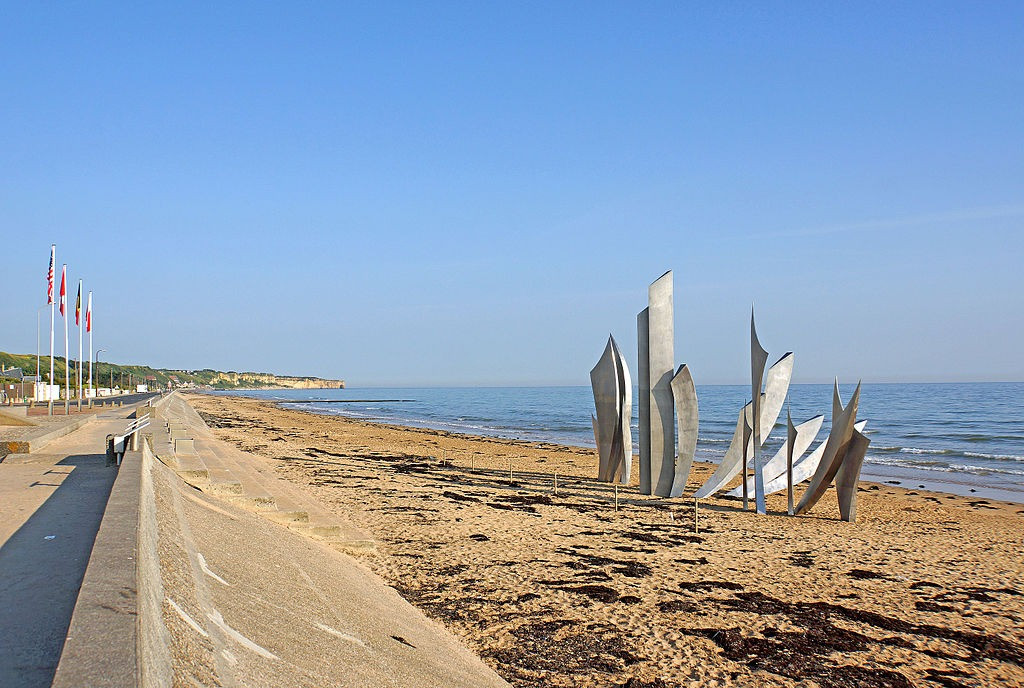How do I get to the D-Day landing beaches from Caen?
The five emblematic D-Day beaches, whose code names were assigned by the Allies in preparation for the military operation, are :
- Sword Beach (Franco-British sector)
- Juno Beach (Canadian sector)
- Gold Beach (British sector)
- Omaha Beach (American sector)
- Utah Beach (American sector)
From Caen, Bayeux or Carentan, the main sites of the Battle of Normandy, including the D-Day landing beaches, are easily accessible by train or bus. In summer, special shuttles provide daily access to the memorial sites.
To reach Caen from other French cities, regular regional flights are offered by our airline, facilitating travel from various points in the country.
1. Sword Beach, the Franco-British landing beach
Located around 30 minutes from Caen, Sword Beach extends over the communes of Hermanville-sur-Mer and Colleville-sur-Orne. This sector, allocated to Franco-British forces, was not initially intended for the D-Day landings, given its proximity to the heavily defended Ouistreham. Because of the coastal reefs, the assault was concentrated on a restricted area, where General Rennie's 3rd British Division, supported by Green Berets and special tanks, operated.
The Pegasus Memorial Museum, 20 minutes from Caen, illustrates this episode in the history of Sword Beach, notably with a life-size replica of the Horsa glider. On the eastern flank, the Merville Battery Museum retraces the battles of the 9th British Parachute Battalion to retake this German fortification. This extensive site offers visitors the chance to visit five bunkers, which have been converted into a museum, plunging visitors into the heart of the D-Day events.
2. Juno Beach, the Canadian landing beach
Stretching from Bernières-sur-Mer to Courseulles-sur-Mer, Juno Beach lies between the British sectors of Sword Beach and Gold Beach, and was entrusted to Canadian forces. Along this coastline, numerous obstacles awaited the troops: anti-tank guns, machine guns and defenses set up along the dykes.
On D-Day, General Keller's 3rd Canadian Infantry Division, supported by British troops, had to contend with rough seas and reefs, which delayed their arrival. The soldiers finally disembarked at high tide, confronted by mines hidden in the sand.
Close to the beach, the Juno Beach Centre tells the story of these thousands of Canadian soldiers. The large villa at the entrance to Bernières-sur-Mer beach, which has become a symbol of D-Day, honours their memory. The emblematic Maison des Canadiens is open all year round, free of charge, at booking.
3. Gold Beach, the British landing sector
Gold Beach, the beach allocated to the British, stretches from Asnelles to Ver-sur-Mer. With the exception of the cliffs to the east of Arromanches, the coastline is low and marshy. On June 6, General Graham's 50th Northumbrian Division landed with relatively little difficulty, but met intense resistance at the fortified Hamel point. Although losses were heavy, reinforcements and specialized armor enabled the British to retake this strategic position during the course of the day.
The Gold Beach area is home to the Musée du Débarquement in Arromanches, the first commemorative museum created after the Second World War. In Arromanches, the circular cinema also offers an immersive experience, projecting archive images of the Battle of Normandy onto several screens, for a captivating immersion in these historic moments.
4. Omaha Beach, the beach of the American landings
Stretching from Colleville-sur-Mer to Vierville-sur-Mer, Omaha Beach stretches for several kilometers at the foot of steep cliffs, making it a strategic location for an amphibious assault. Despite its risks, this beach was the only viable option between Gold Beach and Utah Beach.
Allied troops faced an intense defense, with numerous points of resistance: anti-tank walls, cannons, machine guns, barbed wire and minefields stretched from the shore to the heights. The American V Corps suffered such heavy losses that the beach went down in history as "Bloody Omaha".
In this area, the Pointe du Hoc, still marked by shell craters, is a must-see site. The Overlord Museum, with its 10,000 exhibits, offers a life-size reconstruction of the D-Day landings. Nearby, the British Memorial at Ver-sur-Mer is dedicated to remembrance and meditation.
5. Utah Beach, the westernmost American sector
Utah Beach, located between Sainte-Marie-du-Mont and Quinéville in the Manche department, is the furthest Landing sector from Caen. Although not part of the original plans, the site was entrusted to American forces for an amphibious assault. Two parachute divisions were also dropped in the night before the offensive, reinforcing the ground troops.
The Musée du Débarquement Utah Beach, erected on the very site of the D-Day events, recounts this landmark story. Nearby, theAirborne Museum in Sainte-Mère-Église is dedicated to American paratroop operations. For an immersive experience, the D-Day Experience lets you relive the Channel crossing in a C-47 flight simulator installed in a real period aircraft.
Image: Dennis G. Jarvis

